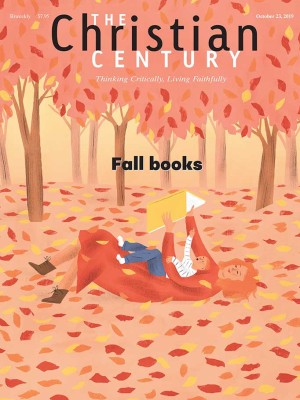November 1, All Saints Day (Luke 6:20–31)
Jesus mourns a human existence unconcerned with the needs of the whole.
People on the ground. Weary, dirty, curious flesh—provocatively close. This is the context for the Sermon on the Plain.
The 12 disciples swell into many, and they hear about their past, present, and future. Jesus references their ancestors; he draws content from their current circumstances. And the question of who and where they will come to be bears weight in the sermonic veracity of this moment.
Jesus is preaching a truth: that the world and this life will always depend on the presence, movement, and impact of people. Huddled and crowded together or sitting on the grass or dirt of an open plain, the people are there. They have come to hear about this man important enough for the Pharisees to follow around and debate. His messages are making an impression. He is always meeting strangers, friend and foe alike. They are drawn to what he has to say. He is saying something that transcends time, that feels available to all.
Read our latest issue or browse back issues.
Blessed are you. Woe to you. The blessing graces this moment but also bears marks in the past. The same can be said of the warning. Can the past be warned? Can the future be consecrated? With this man it seems so. They follow his message, the people who are on the ground—who are the message’s context.
If Jesus can speak across time, he can surely speak across different groups of people. They are all his disciples, whether they agree or not—whether they know it or not. He is teaching them, guiding this moment of their lives. They are his pupils, and they are many. They have become the collective for whom the Gospel of Luke is written.
Oftentimes Luke is characterized as a universal Gospel. It is a book of social implications, categories, and narratives, says James Malcolm Arlandson. Justo González calls it a book for “a mostly Gentile audience.” However specific its individual moments, the book’s implications are wide. Every person can find their message in this man’s words.
And the Sermon on the Plain parses out accountability to all those who hear it, not just some of them. It does not divide people according to category. It produces two parties: the proclaimer and the hearers, the revelator and the listeners.
The simplicity of this grouping must not be lost on us. It is Jesus who proclaims and all those present who hear. Jesus is not speaking in one moment to a group of well-to-do people and in the next to the poor who would not be welcomed by the first group. The message is not separate, because the people on the ground are not separate. They are all there; they are all together. They are one, privy to the same message, hearing what is applicable to them—and what they believe is not. They are made community under the sound of his voice; they are the communal pupil.
While it’s a textual relative to portions of Matthew 5–7, Luke 6:20–31 remains true to itself. Jesus’ message is the focus of this passage, yet its heart is the people on the ground. The inhabitants of the moment grant the message poignance and importance.
But they have to be present—not only in body but also in mind. People who came to be healed also hear. The moment is littered with reversals. The poor receive welcome, the hungry eat, the distraught laugh. The rich, the full, and the well-received experience the opposite as well. And not only does Jesus command reversals, he also reverses what reversals mean. Reversals are not reversals at all but truths about the self. Do unto others as you would have them do unto you. Fortune (“blessed”) and grief (“woe”) can exist in proximity, in the same crowd, perhaps in the same person sitting on the ground.
Jesus wishes good fortune for those in his presence. He also mourns a human existence unconcerned with the needs of the whole. A fractured life is one that God enfleshed can preach about to 12 men listening to their newly minted leader, to men of religious distinction listening intently for points they can counter, to people suffering illness in their body and in their capacities, to those who do not know lack. God speaks to them all, for they all sit on the ground—on a hill where the wildlife is privy to the message as well, the earth bearing witness to a message it has known for millennia. It’s a wild classroom for the many to learn the lessons of the Creator.
The tutorial is not for humanity alone. Humans are merely the latest students to arrive, the last becoming first. Who else but the earth knows to do good to those who hate it, to pray for those who abuse it? Who else gives its coverings freely and gives away its good?
When the people come together, they gain a lesson in wholeness. They are told of the fractured past and present and encouraged to live in another way, a way demonstrated to them by the living earth under their feet.
All of creation is one disciple, together amidst the flesh of dirt—its aches and illnesses, its abuses and violence. Creation is one, its members mixed together hearing echoes of the Creator, redirecting their lives away from messages of conquering and amassing things that do not matter.
Instead, assembly will do—people assembled together, weary and dirty and provocatively close. It is gospel. It is the blessing, and it cures the woes.






